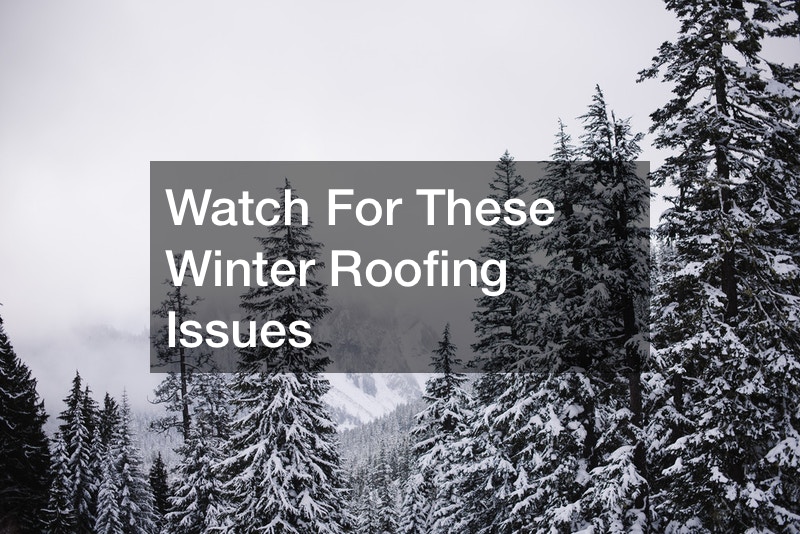
Most people think of a roof repair as something that happens in the spring and summer. However, roof repair in the winter is sometimes necessary. Some unique problems may require roof repair in the winter.
Expert residential roof repair is available year-round to address any problems that may crop up. Roof repair in the winter can provide some challenges, but an experienced roof company will be able to handle any issue.
Ice Dams
A build-up of ice that melts and refreezes is called an ice dam. This is one of the most common wintertime problems a roof faces. Ice dams build up on the edge of a roof and prevent melting runoff from moving off the roof.
An ice dam will cause water to pool behind the dam. The pooled water can leak into the home and cause a wide range of potential problems, including damage to insulation, ceilings, and walls. It can also encourage mold growth.
Roof repair in the winter can include clearing the snow off the roof. A snow rake is a handy tool that a professional can use to remove the snow from your roof. If you have easy access to your roof, it is something that you can do yourself, but you do want to be careful that you do not damage the roof. Of course, you also want to make safety a priority.
Snow Build Up

Many homeowners do not think about the amount of weight their roof can tolerate. Snow and ice can be heavy. The weight of snow and ice can damage your roof, leading to necessary roof repair in the winter.
Snow can weigh between 21 pounds and 24 pounds per cubic foot. That is a lot of weight on your roof. In most cold-weather regions, roofing materials are rated for heavier weight. However, if you live in an area that normally does not get a lot of snowfall, your weight limits can be substantially less. Complete roof cave-ins are rare from snow weight, but they do occur. The more likely result of an abundance of snow is damage to part of the roof.
As with all roof repair, it is always best to get the roof repair in the winter caused by snow build-up done as soon as possible. The sooner you address the problem, the sooner you can rest easy knowing the problem is solved.
Fallen Branches
Fallen branches are a risk any time of year, but they can be a special hazard that requires roof repair in winter. The weight of ice and snow is not only bad for your roof, but it is bad for any branches hanging over your roof. It does not take much more than a stiff wind to break these overly burdened branches and send them crashing right through your roof.
Falling branches are not the only problem. Sometimes the branch does not completely break. Instead, it hangs close enough to your roof to rub away at the asphalt shingles, which can wear them down. Over time roofing materials lose their effectiveness from the additional wear and tear, and you could wind up with a leak.
Your gutters are also in danger from branches that hang even lower in the winter from the ice and snow. Roof repair in the winter may have to include complete gutter replacement services. One key way to avoid roof repair in the winter from fallen branches is to do some tree trimming to keep those branches away from the house.
Blizzard Conditions and High Wind

The difference between a snowstorm and a blizzard is the amount of wind that accompanies the snow. It is not unusual to experience some wind damage to a roof during a raging blizzard. Roof repair in the winter is sometimes needed to address the damage.
With a long stretch of severely cold temperatures, asphalt shingles can actually freeze if the wind is fierce as well. This can mean serious damage to the roofing shingles. Replacing missing or broken roof shingles as soon as possible is vital to keeping your roof in top condition and ensuring that it is protecting your home.
Roof Replacement in The Winter

In extreme cases, roof repair in winter simply will not get the job done. For example, the damage to your roof from a fallen tree limb does not allow for a simple repair because the damage is extensive. Can your roof be replaced in the winter while you and your family remain in the home?
Several factors play a role not only in whether your roof can be replaced in the winter but whether you and your family can or should remain in the home. The weather is a variable that no one can control. Roofers cannot work on a roof when it is snowing or when the temperatures are truly extreme. In some cases, the major replacement jobs have to wait until things warm up a little bit. If you live in one of the colder states like Minnesota, roof replacement cannot be done in the thick of winter.
New roof installation in the winter in the southern tier states is usually possible any time during the winter. There is an option for replacing your roof in the winter, but your property may not be well-suited for it.
Re-roofing is an option that is often used to save money, cut down on the amount of work, and keep from having to rip the old roof off. The beauty of re-roofing your home in the winter is that you and your family can continue to live in the house comfortably.
Not every roofing company offers re-roofing as an option, and not every roof can be re-roofed, but it is an option worth asking about if you need roof repair in the winter. It can save you money and make it easy to stay home while your roof is being redone.
If you have already taken advantage of this option, you cannot do it a second time. You can only re-roof a roof one time.
Condensation Is Your Roof’s Enemy
Condensation is a problem for your roof, but it is not the only part of your home that can fall victim to the damage it can cause. Just ask siding contractors about what happens when condensation gets behind your siding.
Condensation forms when heated air from inside the house collides with your cold roof. The air rapidly cools and forms condensation. This moisture response can cause a wide range of problems both inside and within the roofing system.
Condensation inside can be easy to spot. You will notice little droplets on the ceiling up in the attic. Condensation can also form under the top layer of roofing materials, which can be harder to spot. You may notice streaking on your shingles, or your may not realize you have a problem until the rot or mold sets in.
Roof repair in the winter can address the problem by correcting venting issues, having masonry services repair chimney problems, and taking other steps. If you have one of the newer “cool roofs” installed, that may be the source of the problem. These newer roofs are usually installed in regions where the summer is sweltering. Cool roofs can help to keep ac costs down by cooling down the building from above. Typically, commercial building companies install these roofs and they are rarely installed on residential properties.
Commercial roofing solutions for condensation problems often include changing the roof composition because the cool roof is the source of the problem. Usually, with residential properties, you do not need to change out the entire roof, but you do need to address some of the common problems that cause condensation.
Condensation can be difficult to recognize for the untrained eye. A roofer can easily find the source of condensation and provide you with repair options for putting the problem to rest.
The Best Way to Avoid Roof Repair In the Winter is Prevention

The best way you can avoid roof repair in winter is to have any repairs done before the winter arrives. A little TLC can go a long way in preparing your roof for winter. Most homeowners do not know that they should have periodic inspections of their roofs.
Having your roof inspected will reveal if there are any loose shingles, if you need some flashing work done, or if any shingles are missing. Roofs are exposed to all types of damaging weather like hail, wind, heavy rain, and the sun’s scorching rays. Inspecting your roof annually will ensure that any problems are discovered early.
If you need any small repairs, get them done early. For example, if you notice any roof debris in the yard after a storm, get a roofer out as soon as possible to make any necessary repairs. When it comes to roofing problems, the problem won’t get better on its own. All roofing problems will get worse with time. The best course of action is to address them as soon as you are aware.
Here are some other things that you should do to prepare your roof for the winter:
- Get a tree service to trim any trees with branches that overhang the roof.
- Clean out your gutters. If you can’t safely clean out your gutters, hire someone who can.
- Have your flashing checked and repaired if necessary.
Taking the time to take care of your roof before bad weather can help prevent wintertime stress. Most roofing services offer maintenance services for your roof. Being proactive is always best.
Sometimes, no matter how good you are about taking care of your roof and doing all the preventive work, there is always the chance that you will need roof repair in the winter. Rule number one of any roofing emergency is don’t panic.
What If You Need Roof Repair in Winter?
Let’s say you followed all the preventive steps, and your roof is still damaged during the winter. It is important that you call in a roofing professional to manage the repairs. Some homeowners try to take on the job themselves, and it ends badly. According to the Bureau of Labor Statistics, roofing is the fourth most dangerous line of work. There are thousands of injuries sustained every year by homeowners from falls while doing roof repairs.
In the winter, roofing comes with some heightened risks. Roof repair in the winter is not a DIY project you should take on.
The most important thing you can do if your roof is damaged during the winter is to ensure that your family is out of harm’s way. If the damage is minor, then it is fine to stay in the house. If the damage has put your roof at risk of a cave-in, find other temporary lodgings until the roof repair can be completed. Any roof that has been compromised to the point where there is a hole in it is structurally unsafe. It is better to put up with the convenience than it is to risk personal injury.
While you are waiting for the roofer, do what you can to minimize damage. Cover the floor immediately under the damage with plastic tarps. Do not attempt to tarp the roof from the outside. If there is a hole in the roof, cover it from the inside. Place buckets and other vessels around any areas that are exposed to the leaky roof.
Roof repair in the winter is not ideal, but an experienced roofer can take care of the problem quickly for you. Just keep your family safe until help arrives.



